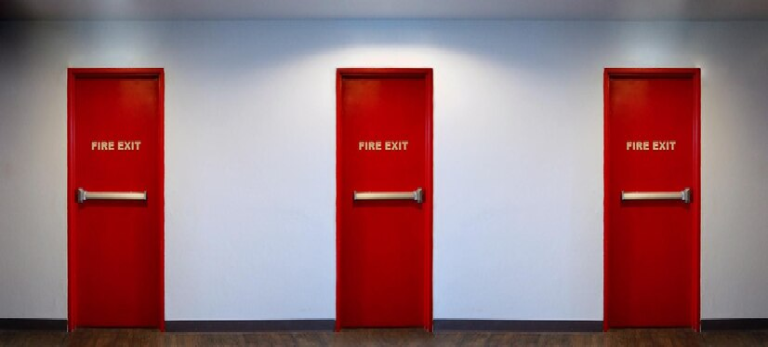In the realm of architectural safety, fire doors stand as unsung heroes, silently guarding against the relentless threat of fire. These unassuming features play a pivotal role in containment, offering a critical line of defence against the chaos of flames and smoke. From their diverse constructions to their crucial placement, these doors weave an essential layer of protection, ensuring both compliance and, more significantly, the safety of occupants. Let’s delve into the world of fire doors, exploring their types, significance, and unwavering commitment to fortifying our spaces against the unpredictable force of fire.
Understanding Fire Doors
Fire doors are specially designed doors constructed with fire-resistant materials. They are strategically placed within buildings to compartmentalise different areas, forming a barrier that impedes the rapid spread of fire. Composed of various layers, including intumescent strips, fire-resistant glass, and solid cores, these doors are engineered to withstand high temperatures for a specified duration, typically ranging from 20 minutes to several hours.
Functionality and Importance of Fire Doors
The primary function of fire doors is to contain the fire within a specific area, confining it to its source and preventing it from rapidly engulfing an entire building. By compartmentalising the fire, these doors buy crucial time for evacuation and enable the fire department to arrive and contain the blaze more effectively.
Beyond merely impeding the spread of fire, fire doors also limit the propagation of smoke and toxic gases. This is vital as smoke inhalation is a leading cause of fatalities in fires. The containment of smoke by these doors aids in maintaining clearer escape routes and reducing health risks for those attempting to evacuate.
Different Types of Fire Doors
Fire doors are available in a variety of styles, each tailored to unique purposes, surroundings, and fire safety regulations. Here are some examples of popular types:
-
Wooden Fire Doors
These doors are constructed using wood and fire-resistant materials. They are aesthetically pleasing and often used in residential buildings or areas where a traditional look is desired.
-
Steel Fire Doors
Constructed from steel and fire-resistant materials, steel doors offer exceptional durability and are commonly found in industrial settings, commercial buildings, and areas with high traffic.
-
Glass Fire Doors
These doors incorporate fire-resistant glass panels within a fire-rated frame. They provide visibility while maintaining fire compartmentation and are suitable for areas requiring light and visibility, such as corridors and offices.
-
Glazed Fire Doors
Similar to glass fire doors, these doors feature fire-resistant glass panels but might have additional framing or be part of a larger fire-rated assembly.
-
Double-Leaf Fire Doors
Consisting of two interconnected door leaves, these doors offer wider openings while maintaining fire resistance. They are commonly used in larger passageways or openings that require a wider clearance.
-
Fire Exit Doors
Specifically designed as emergency exits, these doors are equipped with panic hardware and are crucial for quick evacuation during emergencies. They are usually marked clearly and provide a swift means of egress.
-
Timber Composite Fire Doors
Combining timber with other fire-resistant materials, these doors offer a balance between aesthetics and fire protection. They are commonly used in residential settings.
-
Solid Core Fire Doors
These doors have a solid core made of fire-resistant materials such as gypsum or mineral cores. They provide robust fire protection and are often used in high-risk areas.
-
Specialised Fire Doors
Some fire doors are designed to offer additional properties like acoustic insulation or protection against radiation. These specialised doors cater to specific needs in particular environments.
Each type of fire door serves a unique purpose, offering varying degrees of fire resistance and meeting different aesthetic and functional requirements.
What Are the Significance of Fire Doors?
Beyond their physical construction, fire doors hold immense significance in regulatory compliance and safety standards. Building codes mandate their installation in specific areas to adhere to fire safety regulations, ensuring the safety of occupants and minimising property damage in the event of a fire outbreak.
The Importance of Maintenance and Inspection
Maintaining fire doors is imperative to ensure their functionality during an emergency. Regular inspections, typically conducted annually, check for damage, proper closing mechanisms, intact seals, and clear pathways around doors. Any deficiencies should be promptly addressed by certified professionals to uphold the door’s fire-resistant capabilities.
Conclusion
Fire doors are the unsung heroes of building safety, offering a critical line of defence against the devastation of fires. Their diverse types cater to various needs, their strategic placement crucial in containing fires and saving lives. Understanding their significance, ensuring proper installation, regular maintenance, and compliance with safety standards are pivotal in fortifying our spaces against the unpredictable threat of fire.
In essence, fire doors transcend their physical presence—they embody meticulous planning and unwavering dedication to protecting lives and property. As silent sentinels, they stand ready to mitigate the chaos of flames, a testament to human ingenuity in the face of one of nature’s most formidable forces.

